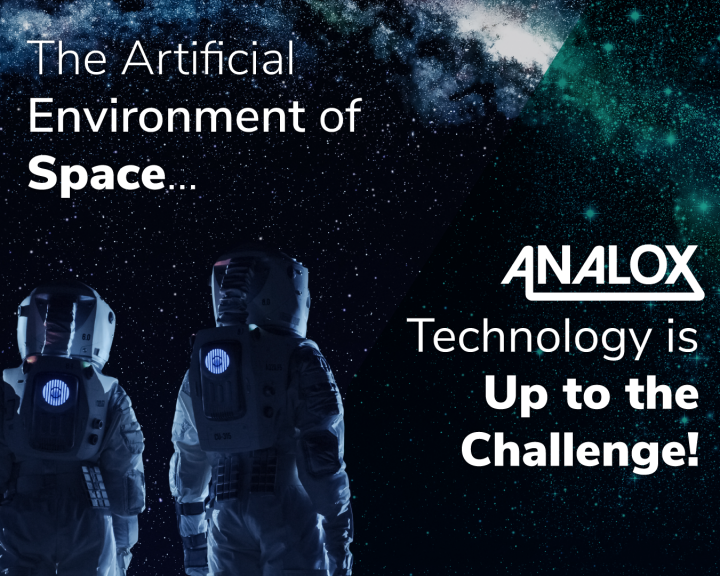THE ARTIFICIAL ENVIRONMENT OF SPACE – ANALOX TECHNOLOGY UP TO THE CHALLENGE
In the classic TV series Star Trek, actor William Shatner famously described space as the “Final Frontier” and a place to “boldly go where no man has gone before.” Over the last decade, the opportunity to explore this “final frontier” through commercial space travel has become not only a reality, but something that’s happening more and more frequently.
Thanks to the efforts of high profile billionaires including Elon Musk, Jeff Bezos and Richard Branson, the opportunity for space exploration is becoming almost routine. Musk’s SpaceX project and its Falcon 9 family of rockets have already recorded more than 130 successful missions with many more scheduled for the future.
Not to be outdone, Bezo’s Blue Origin company made history and headlines in October when a New Shepard rocket propelled the 90-year old Shatner 66 miles into the sky to become the oldest human ever in space.
In early December, Blue Origin will add NFL Hall of Famer Michael Strahan to the list of celebrities heading to space. Strahan will join Laura Shepard Churchley, daughter of legendary Mercury astronaut Alan Shepard, the second man in space. Bezos named the Blue Origin space capsule in Shepard’s honor. Well-known celebrity figures including Angelina Jolie, Leonardo Dicaprio and James Cameron have all reportedly purchased a ticket on a future space flight – at $250,000 per seat.
As space travel becomes more mainstream, one thing hasn’t changed – the need for safe, reliable vehicles that can withstand the rigors of space travel and the inherent challenges it presents. The Analox Group’s engineering team has been working with aerospace engineers, scientists and space exploration teams since 2011. During that decade, the Analox Team has helped craft monitoring solutions enabling space vehicles to measure O2 (oxygen), CO (carbon monoxide), CO2 (carbon dioxide), temperature and humidity.
While accurate gas monitoring is important in all aspects of life, it’s even more crucial in the foreign environment of space. To help maintain proper life support in a space vehicle, scientists use “synthetic air”. This specially developed air eliminates impurities and provides a key element of control and precision crucial for space travel. In earth orbit at an altitude of 200-plus miles, there is no margin for error.
Unfortunately, the synthetic air is significantly more dry than typical O2, making breathing less comfortable for the astronauts. To counter this, atmospheric technicians add small amounts of moisture (humidity) into the environment. However, too much moisture, in the form of condensation and humidity can potentially cause damage to monitoring devices and sensors. To help address this issue, Analox created the SV-HAT Mission Critical Gas Detector which uses laser technology to accurately measure humidity and temperature.
The SV-HAT is just one Analox device currently in use in space vehicles being operated by both the public, private and governmental sectors. Another vital tool used in space operations is the SV-MULTISENSOR 2 which simultaneously measures O2 and CO2 levels. According to gas engineers and life-support specialists working in the aerospace industry, Analox technology is a preferred option because of its precision, longevity, accuracy and maintenance simplicity.
Private companies like SpaceX and Blue Origin aren’t just concentrating their efforts on passenger space travel, although it can be quite lucrative due to the public’s growing interest. The companies are also competing for payload contracts with government agencies including NASA.
In November, SpaceX launched the Falcon 9 “Heavy” rocket that delivered NASA’s Double Asteroid Redirection Test (DART) mission to an interplanetary transfer orbit. DART is the world’s first planetary defense test mission to see if intentionally crashing a spacecraft into an asteroid is an effective way to change its course, should an Earth-threatening asteroid be discovered in the future.
This was SpaceX’s first interplanetary mission and is another example of how popular movies and culture can mirror actual scientific realities. The 1998 Bruce Willis film “Armageddon” actually centered on the premise of NASA launching rockets to protect the earth from an approaching asteroid.
There is still extensive research being done about life outside of the earth’s atmosphere.
Astronauts aboard the International Space Station (ISS) have been growing vegetables in space for many years. Leafy greens have served as meals for the crew since 2015. More recently ISS crew members sampled the first peppers grown in space.
In all, there have been ten different types of crops grown in test conditions. As more and more “space agriculture” is explored, it is likely that Analox technology will be implemented there as well. There are certainly some unique challenges growing crops in space. For healthy plants to grow, there needs to be a constant supply of CO2. While productive for plants, CO2 exposure can be unhealthy for humans. That’s why proper monitoring of CO2 (whether on earth or the International Space Station) is critical.
As technology changes and the growth of space travel and exploration continues, count on the team of professionals at the Analox Group to stay at the forefront of atmospheric technology, safety and reliability.
